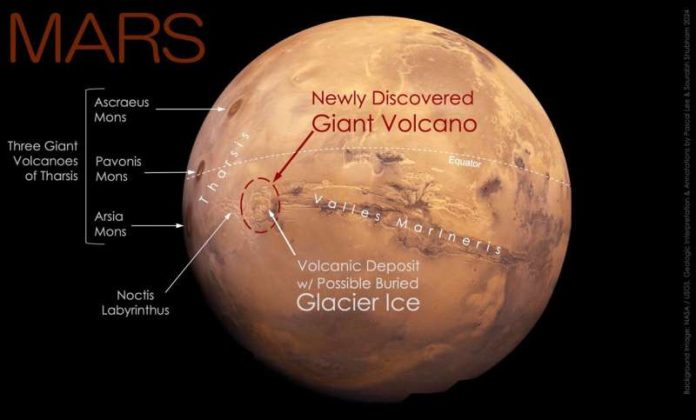
In a recent exciting update from the 55th Lunar and Planetary Science Conference in The Woodlands, Texas, scientists shared a remarkable discovery on Mars.
They found a massive volcano and a possible hidden glacier ice sheet in the eastern part of Mars’ Tharsis volcanic region, close to the equator.
This discovery is thrilling because, although orbiting spacecraft have been taking pictures of this area since the Mariner 9 mission in 1971, the true nature of this giant volcano was overlooked due to its eroded state, blending into the dramatic landscapes of Mars’ Noctis Labyrinthus and the vast Valles Marineris canyons.
The volcano, temporarily called “Noctis volcano,” stands impressively tall at about 29,600 feet and stretches over 280 miles across.
Its significant size and the complexity of its erosion patterns suggest it’s been active over a long period, marking a fascinating chapter in Mars’ geological story. Particularly intriguing is the southeast part of the volcano, where a fresh volcanic layer hints at the presence of glacier ice beneath.
This discovery is a big deal for several reasons. It offers a new spot for scientists to delve into the geological evolution of Mars, search for life, and plan future robotic and human exploration missions.
Dr. Pascal Lee, a planetary scientist from the SETI Institute and the Mars Institute at NASA Ames Research Center, and the lead author of the study, stumbled upon this discovery while investigating a previously identified glacier remnant. The team realized they were standing on a colossal, deeply eroded volcano.
Analyzing the landscape, they identified a series of elevated mesas and slopes radiating from the volcano’s center, a caldera remnant, and various signs of volcanic activity, such as lava flows and deposits of volcanic ash and minerals. These features collectively pinpoint the area as a significant volcanic site.
The study also uncovered a 1930 square mile area within the volcano filled with unique, blister-like mounds. These are thought to be “rootless cones,” formed when volcanic material interacts explosively with water or ice underneath.
This interaction suggests that a vast sheet of glacier ice might still be hiding beneath this volcanic layer, a theory supported by the presence of certain minerals formed when volcanic heat meets ice.
The discovery of the Noctis volcano enriches our understanding of Mars’ complex history, involving cycles of volcanic activity, fracturing, and glaciation.
This volcano is essentially a giant shield constructed from layers of volcanic materials and ice, sculpted over time by thermal erosion, glacial action, and the gradual uplift of the Tharsis region itself.
What makes the Noctis volcano particularly fascinating is its potential for harboring life. The long-term interaction of heat and water in this region could have created conditions favorable for life to exist.
Plus, the possibility of glacier ice near the equator makes this an ideal location for future exploration, offering easier access to water resources for astronauts.
The research team used data from several Mars missions, including NASA’s Mariner 9, Viking Orbiters, Mars Global Surveyor, Mars Odyssey, and Mars Reconnaissance Orbiter, as well as ESA’s Mars Express mission, to uncover the secrets of the Noctis volcano.
This study not only highlights the value of these missions but also the importance of the open data and visualization tools that helped bring this discovery to light.
As scientists continue to unravel the mysteries of the Noctis volcano, this area of Mars stands out as a promising new frontier for studying the planet’s geologic evolution, investigating the potential for past life, and planning future missions to explore the Red Planet’s surface.
The research findings can be found here.
Copyright © 2024 Knowridge Science Report. All rights reserved.



